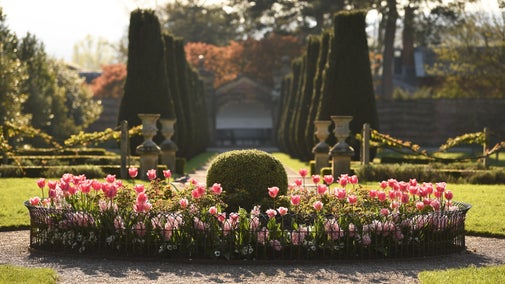The race is on to hand trim a 168 lime trees at Erddig ready for their annual spring glow up
- Published:
- 24 April 2023

The annual task of pleaching a 168 lime trees at Erddig, North Wales is underway and estimated to take a total of 65,000 snips for a small team of staff and volunteers to complete, ready for them to burst into leaf by mid-May.
The avenues of lime trees were planted at Erddig, North Wales in 1976 by Head Gardener Mike Snowden who set about restoring the Grade I listed garden to its 18th-century formal design.
Earlier this April, Head Gardener Glyn Smith started the annual task of pleaching the lime trees which involves trimming each branch by hand, estimated to take a total of 65,000 snips along 168 trees. If it weren’t for a small team of staff and volunteers who support with this momentous task, it would take one gardener 10 weeks to complete.
Glyn Smith, Head Gardener at Erddig, National Trust Cymru said;
“We’re over halfway through the skilled task of pleaching the lime trees and are aiming to finish next week. The trees will then burst into leaf a week or so later. It’s a sight we and many visitors look forward to every year.”
They aren’t your typical lime trees though; they don’t produce zesty limes, but they do get their name from the limey scent they give off when they flower in the summer. These are of a moderately vigorous hybrid lime, Tilia x euchlora and make for a stunning sight in the garden.
Glyn Smith has been the Head Gardener at Erddig for 37 years hasn’t missed a year of pleaching the trees. He knows every trunk, stem and knot, and explains the skilled work involved to trim and train the trees yearly;
“Pleaching the trees is the method we use where we train the trees to produce a narrow screen or hedge by tying in and interlacing flexible young shoots along a supporting framework. Each of the branches have been grafted together to join with their neighbour.”
“It’s important to keep the trunk or stem of the tree clear, so a big part of the task is also cutting away new shoots, so that the height and the formal appearance of the trees remain tidy and encourages dense growth.”
“The linear hedge then provides shelter and shade for many habitats such as birds and invertebrates. In former times, as now, they also give shade to those walking in the garden.”
The trees provide a show stopping display throughout the year, with spring being the most anticipated season as the heart-shaped leaves emerge, green with a yellowish underside.
Early autumn sees the leaves turn a deep yellow before falling to the ground, revealing the grooved bark and deep russet twigs, giving all year-round structural interest to the garden.
Plan your visit to Erddig at www.nationaltrust.org.uk/erddig

You might also be interested in

History of the garden restoration at Erddig
Discover how Head Gardener Mike Snowden uncovered and restored the former glory of Erddig’s garden, by consulting plans and reading clues in the land.

Visiting the garden at Erddig
From daffodils in spring to 180 apple varieties in autumn, find out about this 18th-century walled garden and its seasonal activities and highlights.

Wales
Explore fairy-tale castles, glorious gardens and a wild Celtic landscape brimming with myths and legends on your visit to Wales.